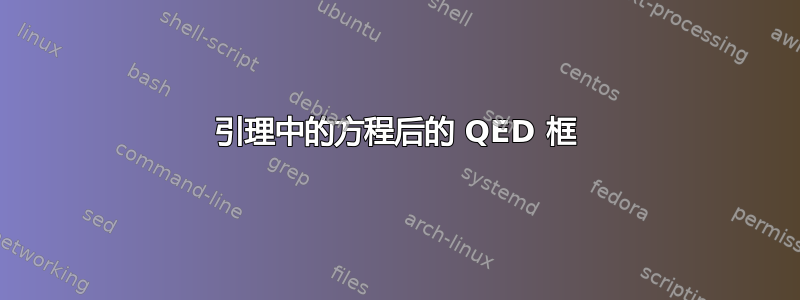
在数学文本中,我有一个引理,我只会陈述而不会证明。我想在结尾处给它一个 QED 框。通常,我可以将命令放在\qed引理的末尾。请参见以下示例:
\documentclass{amsart}
\theoremstyle{plain}
\newtheorem{lemma}{Lemma}
\begin{document}
The reader is familiar with the following statement:
\begin{lemma}
If $a, b, c$ denote the sides of a rectangular triangle, and if $a$ denotes the longest side, then
%
\begin{equation*}
a^2 = b^2+c^2.
\end{equation*}
\qed
\end{lemma}
\end{document}
它生成一个几乎符合我愿望的 PDF 文件:
我的问题是 QED 符号太低。这是由于方程环境造成的。环境中也出现了同样的问题proof,但在proof环境中可以通过将qedhere方程环境放入其中来解决。
我天真地尝试将\qedhere我的方程放入引理中。该命令没有效果,即没有出现 QED 框。当我将\qed方程环境放入其中时,就像
\begin{equation*}
a^2 = b^2+c^2. \qed
\end{equation*}
然后我得到了下面的结果,这也是我不喜欢的:
\qedhere是否有其他环境中可以使用的类似命令proof?如果没有,是否有简单的方法可以得到我想要的?
我授予了这两个职位:
未经证明的陈述后的 QED 符号
如何在对齐环境中制作 qed 框
但似乎它们都未能解决我的问题。
答案1
noproof您可以为不需要证明的语句定义包装器环境。\qedhere如果语句以显示结尾,您仍然需要。您可以将其与引理、命题甚至定理一起使用。
\documentclass{amsart}
\theoremstyle{plain}
\newtheorem{lemma}{Lemma}
\NewDocumentEnvironment{noproof}{m}{% #1 is the inner environment
\par\pushQED{\qed}\UseName{#1}%
}{\popQED\UseName{end#1}}
\begin{document}
The reader is familiar with the following
statements \ref{test1}~and~\ref{test2}.
\begin{noproof}{lemma}\label{test1}
If $a, b, c$ denote the sides of a rectangular triangle, and if
$a$ denotes the longest side, then
\begin{equation*}
a^2 = b^2+c^2.\qedhere
\end{equation*}
\end{noproof}
\begin{noproof}{lemma}\label{test2}
All animals are equal.
\end{noproof}
\begin{lemma}
This is unreferenced.
\end{lemma}
\begin{proof}
Easy exercise.
\end{proof}
\end{document}
答案2
您可以使用 thmtools 定义一个qedlemma始终以 qed 符号结尾的环境,然后\qedhere在 中使用equation*。
\documentclass{amsart}
\usepackage{thmtools}
\declaretheorem{lemma}
\declaretheorem[qed,name=Lemma,sibling=lemma]{qedlemma}
\begin{document}
The reader is familiar with the following statement:
\begin{qedlemma}
If $a, b, c$ denote the sides of a rectangular triangle, and if $a$ denotes the longest side, then
%
\begin{equation*}
a^2 = b^2+c^2. \qedhere
\end{equation*}
\end{qedlemma}
\end{document}






